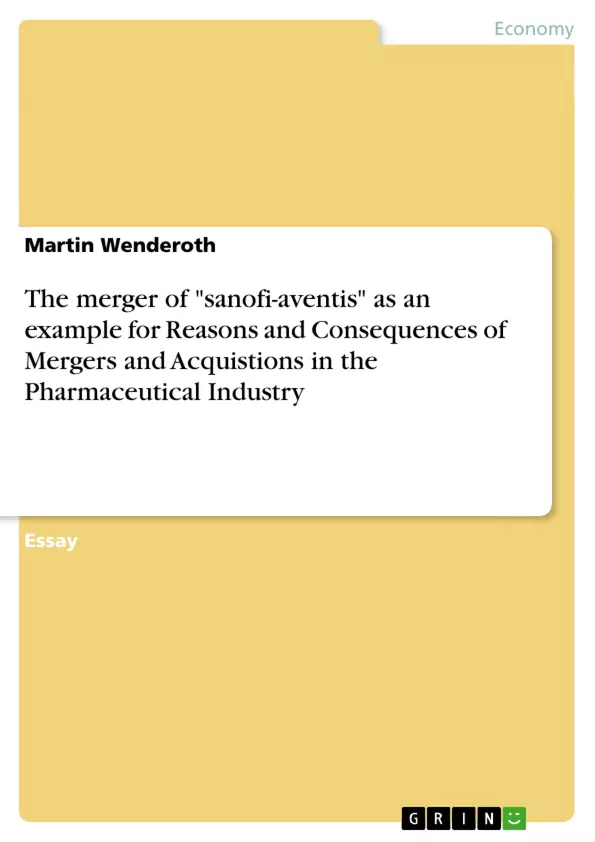Within the ongoing globalisation process, many national markets and industrial branches are in different phases of the transition from local to global economic structures (Bryan, L.; Fraser, J.; Oppenheim, J. Rall, W., 2000, pp. 71-95). As a result of this development organisations in the different industries are increasingly concentrating (Brühl, V., 2003, pp. 274-278).
Among other industries, also the pharmaceutical industry is highly influenced by the above mentioned trend, reflected by the increasing number of mergers and acquisitions (M&A’s) in the pharmaceutical industry, which is illustrated in the following figure.
Figure 1:
The present assignment is going to evaluate the reasons and consequences of M&A’s within the pharmaceutical industry by using the sanofi-aventis merger as an example. First of all, the recent history of sanofi-aventis is briefly described. The third part will describe the reasons and consequences of mergers and acquisitions in the pharmaceutical industry by describing the challenges the pharmaceutical branch is confronted with and the respective motives of and results from M&A activities. Finally, the major findings are summarised and conclusions will be derived.
2. History of sanofi-aventis
Following the company homepage of sanofi-aventis (20071), the year 1999 has been very im-portant because of two reasons.
First of all, Sanofi took over the Synthelabo Holding GmbH and changed its company name to Sanofi-Synthelabo. Furthermore, Hoechst merged with Rhône-Poulenc, a French chemical and pharmaceutical organisation in order to form the new company Aventis, with its legal seat in Strassbourgh (...)
Inhaltsverzeichnis (Table of Contents)
- 1. Introduction
- 2. History of sanofi-aventis
- 3. M&A’s in the Pharmaceutical Industry
- 3.1. Reasons for M&A’s in the Pharmaceutical Industry
- 3.2. Motives of Merging Organisations
- 3.2.1. Synergy Effects
- 3.2.2. Focus on Core Competences
- 3.2.3. Market Power
- 3.2.4. Management Motives
- 3.3. Consequences of M&A’s in the Pharmaceutical Industry
Zielsetzung und Themenschwerpunkte (Objectives and Key Themes)
This assignment evaluates the reasons and consequences of mergers and acquisitions (M&As) in the pharmaceutical industry, using the sanofi-aventis merger as a case study. It examines the historical context of the merger, explores the driving forces behind M&A activity in the pharmaceutical sector, and analyzes the resulting consequences.
- The impact of regulatory hurdles and patent expirations on pharmaceutical companies.
- The various motives behind mergers and acquisitions in the pharmaceutical industry, including synergy effects, focus on core competencies, and market power.
- The consequences of M&As, such as job losses, changes in production, and the potential for price wars.
- The role of management motives in driving M&A activity.
- The ongoing challenges faced by the pharmaceutical industry and the potential for future consolidation.
Zusammenfassung der Kapitel (Chapter Summaries)
Chapter 1: Introduction briefly introduces the increasing concentration in the pharmaceutical industry due to globalization and the rising number of M&As, using the sanofi-aventis merger as a case study.
Chapter 2: History of sanofi-aventis provides a concise overview of the key events leading to the formation of sanofi-aventis through the mergers of Sanofi, Synthelabo, Hoechst, and Rhône-Poulenc.
Chapter 3: M&A’s in the Pharmaceutical Industry delves into the reasons behind M&As in this sector. This includes the challenges posed by stringent regulatory approvals for new pharmaceuticals, patent expiries leading to generic competition, pressure from healthcare systems to reduce prices, and the rising importance of direct-to-customer marketing. The chapter further details the motives of merging organizations, such as achieving synergy effects, focusing on core competencies, gaining market power, and potential management-driven incentives.
Schlüsselwörter (Keywords)
Pharmaceutical industry, mergers and acquisitions (M&As), sanofi-aventis, synergy effects, patent expiry, generic competition, healthcare systems, market power, regulatory approvals, R&D, cost reduction, job losses, price competition, management motives, industry consolidation.
- Arbeit zitieren
- Dipl.-Kfm. (FH), MBA Martin Wenderoth (Autor:in), 2008, The merger of "sanofi-aventis" as an example for Reasons and Consequences of Mergers and Acquistions in the Pharmaceutical Industry, München, GRIN Verlag, https://www.grin.com/document/122117



